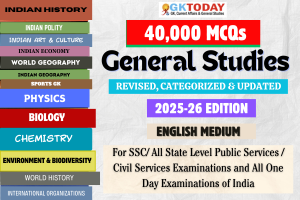Multiple choice questions on Medieval Indian History for General Studies and GK preparation of SSC, NDA, CDS, UPSC, UPPSC and State PSC Examinations.
21. With reference to the Chola administration, which among the following was found in centres of trade and commerce, since it was devoted entirely to serving the interests of the mercantile community?
[A] Ur
[B] Perunguri
[C] Nagaram
[D] Sabha
Show Answer
Correct Answer: C [Nagaram]
Notes:Under Cholas, the general assemblies were of three types:
- the ur, comprising of the tax-paying residents of an ordinary village.
- the sabha, whose membership was open only to the Brahmans of the village or else was found exclusively in villages gifted to brahmans;
- the nagaram, found in centres of trade and commerce, since it was devoted entirely to serving the interests of the mercantile community.
The Chola economy was based on a three- tiered system. At the local level, agricultural settlements formed the foundation. Groups of these communities were, in turn, linked to commercial towns called “nagaram,” which acted as redistribution.
22. The Mansabdari System was borrowed from the system followed in which of the following countries?
[A] Afghanistan
[B] Turkey
[C] Mongolia
[D] Persia
Show Answer
Correct Answer: C [Mongolia]
Notes:
Mansabdar implies the generic term for the military-kind grading of all royal functionaries of the Mughal Empire. The Mansabdari system introduced by Akbar was borrowed from the system followed in Mongolia.
23. Mahmud of Ghazni had maintained an ideological link to the suzerainty of which caliphate?
[A] Fatimid Caliphate
[B] Abbasid Caliphate
[C] Ummayid Caliphate
[D] None of them
Show Answer
Correct Answer: B [Abbasid Caliphate]
Notes:
Despite being an independent ruler, Maḥmud preserving an ideological link to the suzerainty of the Abbasid Caliphate. The caliph, in return, recognized him as the legitimate ruler of the lands he occupied and encouraged him in his conquests.
24. Which of the following matches of political and military performers maintained by the Marathas with their respective duties is/ are correct?
[A] Jasuds- Spies
[B] Harkaras- Messengers
[C] Both of them
[D] None of the above
Show Answer
Correct Answer: C [Both of them]
Notes:
The Marathas appointed “Jasuds” for espionage or spying related work and “Harakaras” for acting as the messengers.
25. With reference to Sultanate era, the terms amil, karkun and mutasarrif stand for__:
[A] Clerks of revenue department
[B] Revenue administrator
[C] Army soldier
[D] Assistant of army official
Show Answer
Correct Answer: A [Clerks of revenue department]
Notes:
The Wazir’s office was called the Diwan – i – Wizarat . Below him in the same department was a deputy called the Naib Wazir . This section handled finance , the income and expenditure of the empire were handled by two official the Mushrif – i Mumalik (income) and the Mustaufi – i Mumalik (expenditure) . Subordinate to him were the clerks in the office who were called Amils, Karkun , and Mutasarrif.
26. The kingdom of Muhammad Ghori included which of the following parts?
1) Afghanistan
2) Tajikistan
3) Turkmenistan
4) Kazakhstan
Select the correct option from the codes given below:
[A] Only 1 & 3
[B] Only 2, 3 & 4
[C] Only 1, 2, & 3
[D] 1, 2, 3 & 4
Show Answer
Correct Answer: C [Only 1, 2, & 3]
Notes:
Muhammad Ghori’s kingdom spanned parts of Afghanistan, Bangladesh, Iran, India, Pakistan, Tajikistan, and Turkmenistan. His 1192 victory at the Second Battle of Tarain established Muslim dominance in Northern India and laid the foundation for the Delhi Sultanate. His general, Qutb-ud-din Aibak, founded the Mamluk Dynasty, the first Delhi Sultanate. Ghori’s strategies shaped medieval South Asia’s political landscape.
27. Who led the Mongol forces at the time of their invasion during Jalauddin Khalji’s rule?
[A] Abdullah
[B] Hulagu Khan
[C] Arkali Khan
[D] Ulugh Khan
Show Answer
Correct Answer: A [Abdullah]
Notes:
During Jalauddin’s rule, Mongols invaded the north-west frontier of the Delhi Sultanate under Abdullah, who was probably one of the grandsons of Hallu (Hulagu Khan). After few skirmishes, the war was avoided by Jalaluddin by paying tributes and friendly exchanges. Jalaluddin also allowed a group of Mongols to settle in lower Ganges plain on the Lakhnauti frontier (Bengal) of his territory. These mongols were called New Muslims.
28. Which of the following was the only Hindu convert to sit on the throne of Delhi?
[A] Alauddin Khalji
[B] Jalauddin Khalji
[C] Mubarak Shah
[D] Khusrau Shah
Show Answer
Correct Answer: D [Khusrau Shah]
Notes:
Nasiruddin Khusrau Shah ruled from 1320 to 1321. Ghazi Malik, the governor of Dipalpur, killed Khusru Shah and ascended the throne of Delhi. He took up the title of Ghiyasuddin Tughlaq in c.1320 CE. Khusrau Shah was the only Hindu convert to sit on the throne of Delhi.
29. Who founded the independent Jaunpur Sultanate?
[A] Ibrahim Shah
[B] Mahmud Shah
[C] Khwajah-i-Jahan Malik Sarwar
[D] Hussain Shah
Show Answer
Correct Answer: C [Khwajah-i-Jahan Malik Sarwar]
Notes:
The Jaunpur Sultanate (1394-1479), founded by Khwajah-i-Jahan Malik Sarwar of the Sharqi dynasty, emerged from the Tughlaq dynasty’s decline. It encompassed Awadh and the Ganga-Yamuna Doab, becoming a cultural hub known as the “Shiraz of India.”
30. Which of the following ruler took the title of Mahmud Begarha?
[A] Ahmad Shah I
[B] Ahmad Shah II
[C] Mahmud Shah I
[D] Hasan Khan
Show Answer
Correct Answer: C [Mahmud Shah I]
Notes:
Mahmud Begada also called as Mahmud Shah I succeeded to the throne in 1458 CE. He raised to the throne at a young age. Mahmud Shah I took the title of Mahmud Begarha.
 These questions are part of GKToday's 40,000+ GK Questions Course in GKToday Android Application which provides more than 40K questions with explanations suitable for all Competitive Exams of India.
These questions are part of GKToday's 40,000+ GK Questions Course in GKToday Android Application which provides more than 40K questions with explanations suitable for all Competitive Exams of India.
